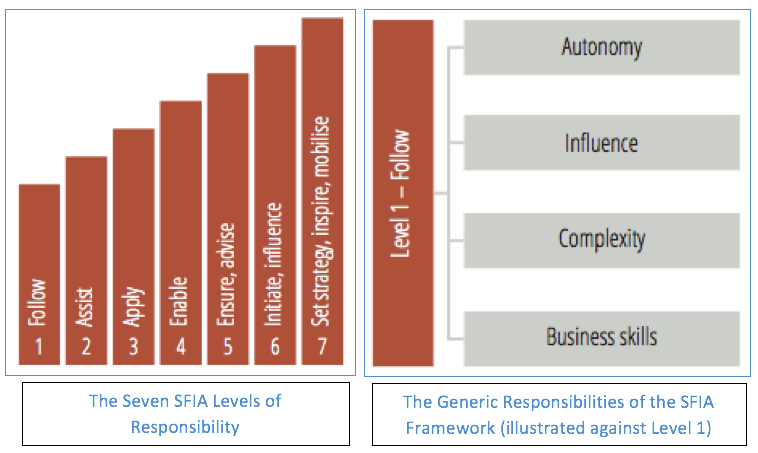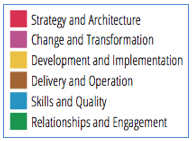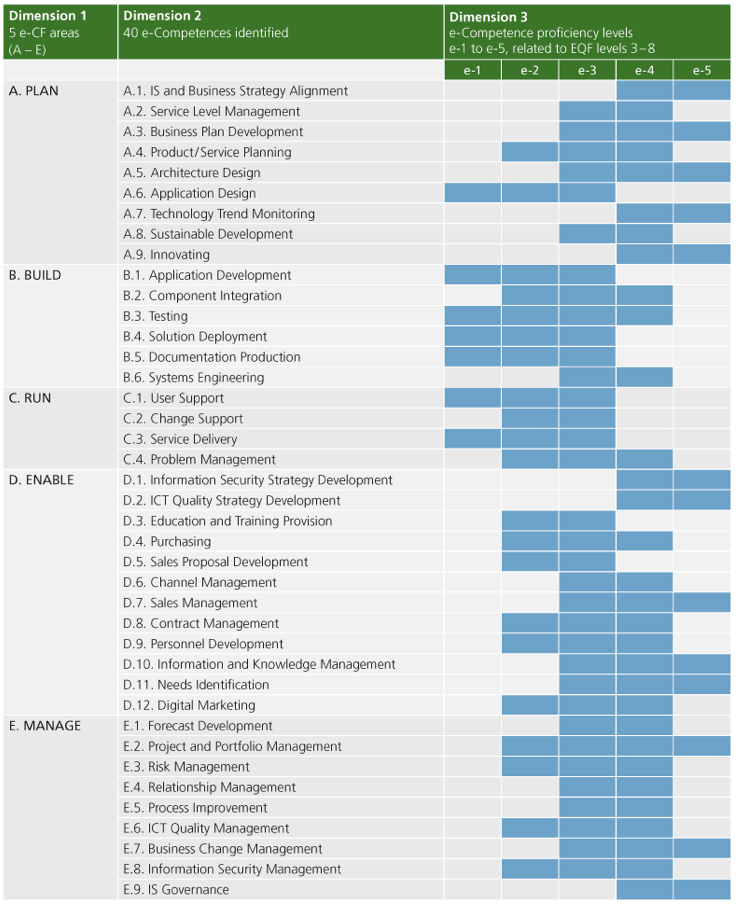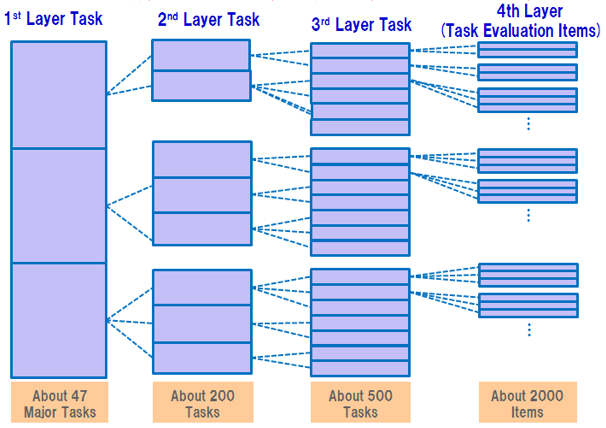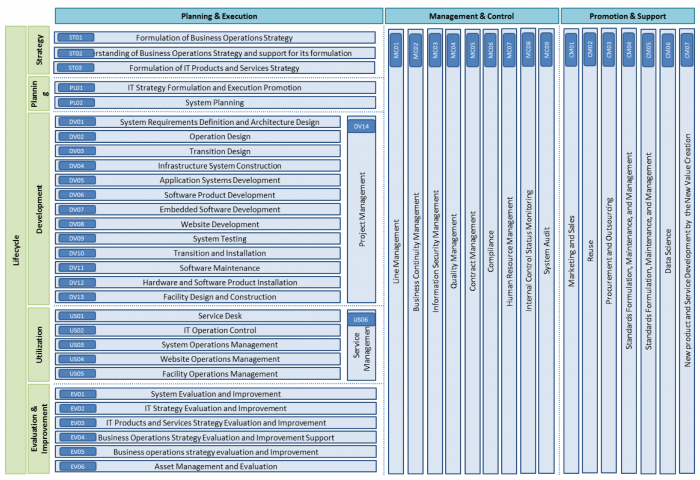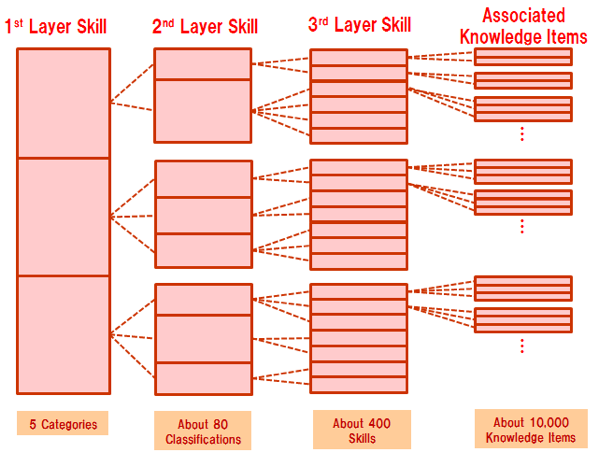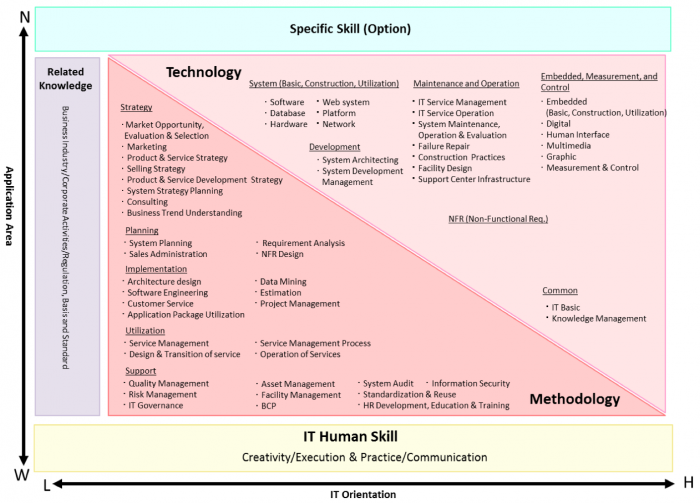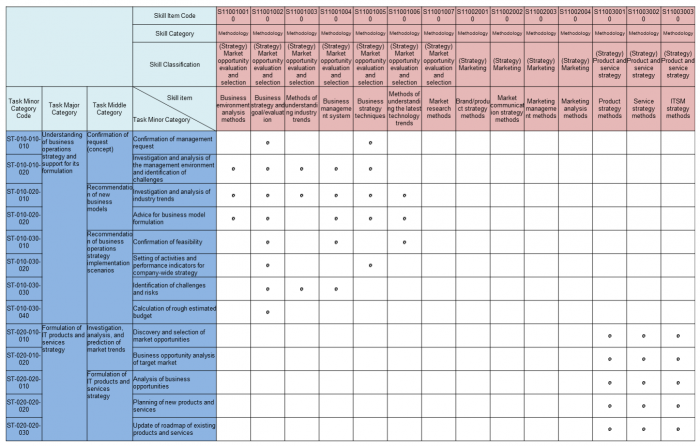Difference between revisions of "Enterprise IT Skill Frameworks"
| (13 intermediate revisions by 3 users not shown) | |||
| Line 1: | Line 1: | ||
| − | < | + | <table border="3"> |
| − | + | <tr><td> | |
| − | + | ||
| − | + | ||
| − | + | ||
| − | + | ||
| − | + | ||
| − | + | ||
| − | + | ||
| − | + | ||
| − | + | ||
| − | + | ||
| − | + | ||
| − | + | ||
| − | + | ||
| − | + | ||
| − | < | + | |
| − | + | ||
<table> | <table> | ||
| − | <tr><th width=" | + | <tr> |
| − | <th>Description</th></tr> | + | <td width="60%"><font color="#246196">'''Welcome to the initial version of the EITBOK wiki. Like all wikis, it is a work in progress and may contain errors. We welcome feedback, edits, and real-world examples. [[Main_Page#How to Make Comments and Suggestions|Click here]] for instructions about how to send us feedback.''' </font></td> |
| − | + | <td width="20%">[[File:Ieee logo 1.png|100px|center]]</td> | |
| − | <tr | + | <td width="20%">[[File:Acm_logo_3.png|175px|center]]</td></tr></table> |
| + | </td></tr></table> | ||
| + | <p> </p> | ||
| + | <h2>Competency Frameworks</h2> | ||
| + | <p>The emphasis on competence has become international as Enterprise IT and ICT in general have become indispensable across the globe. They derive from a growing understanding of the need for a common language for competences, knowledge, skills, and proficiency levels that can be understood across national borders. A common framework enables the identification of skills and competences that may be required to successfully perform duties and fulfill responsibilities in an EIT workplace. They provide a common basis for the selection and recruitment of EIT staff, as well as forming the basis for employment agreements, professional development plans, and performance evaluation for ICT professionals.</p> | ||
| + | <p>Many national and regional governments require the certification of EIT practitioners. Accordingly, they have had to develop their own definitions of ICT competences. Given the increasingly international composition of the EIT workforce, the EITBOK has included information from three major frameworks that are emerging as inter-regional. In general, these frameworks work towards a common understanding of competence, defined by the e-CF as "demonstrated ability to apply knowledge, skills, and attitudes to achieve observable results."</p> | ||
| + | <p>Creating mappings between these frameworks and our chapters is challenging, because they come from different perspectives and have different goals. There is rarely a 100 percent correspondence between the frameworks and our chapters, and, despite careful consideration some subjectivity was used to create the mappings. Please take that in consideration as you review them.</p> | ||
| + | <h2>Skills Framework for the Information Age</h2> | ||
| + | <p>SFIA has been used for some 26 years and was developed using a collaborative approach. The internationally represented SFIA Council oversees the direction of development for the not-for-profit SFIA Foundation, which owns and regularly updates the framework, using a well-established open process, for the benefit of the EIT industry and EIT professionals. The SFIA Framework has been translated in to six languages (English, Spanish, German, Arabic, Japanese, and Chinese with more languages scheduled including French and Canadian French). The SFIA Framework has been downloaded and used by organizations and individuals in nearly 180 countries. It can be downloaded for free at www.sfia-online.org.</p> | ||
| + | <p>The SFIA Framework identifies 97 professional skills across EIT and supporting areas and seven levels of responsibility. The seven levels in the SFIA Framework are used to provide generic levels of responsibility and to reflect experience and competency. The SFIA Framework is based on the demonstrated ability of applying a skill at a particular level, and employing professional and behavioral skills as well as knowledge. The definitions describe the behaviors, values, knowledge, and characteristics that an individual should have in order to be considered competent at a particular level. Underlying each SFIA level are generic responsibilities of autonomy, influence, complexity, and business skills. These are described at each SFIA level. </p> | ||
| + | <p>[[File:SFIA_ResponsibilityLevels.png]]<br /><div id="Fig1"></div>'''Figure 1. SFIA Levels of Responsibility'''</p> | ||
| + | <p>The 97 EIT skills of the SFIA Framework are grouped into categories and sub-categories. A skill has a name, a code, a skill description, and a level description (for that skill at each level practiced).</p> | ||
| + | <table border="1" cellpadding="5"> | ||
| + | <tr valign="top"><th style="background-color: #58ACFA;" width="20%"><font color="white">Attribute</font></th><th style="background-color: #58ACFA;"><font color="white">Description</font></th></tr> | ||
| + | <tr valign="top"><td>'''Generic responsibilities'''</td><td>The generic responsibility attributes delineated for all skills at all SFIA levels: | ||
<ul><li>Autonomy</li> | <ul><li>Autonomy</li> | ||
| − | |||
<li>Influence</li> | <li>Influence</li> | ||
| − | <li>Business | + | <li>Complexity</li> |
| − | <tr | + | <li>Business skills</li></ul></td></tr> |
| + | <tr valign="top"><td>'''Skill category'''</td><td>A logical grouping of the skills for the purposes of navigation. | ||
[[File:SFIA_SkillCategories.png]] | [[File:SFIA_SkillCategories.png]] | ||
These categories are further broken down into sub-categories.</td></tr> | These categories are further broken down into sub-categories.</td></tr> | ||
| − | <tr | + | <tr valign="top"><td>'''Skill name'''</td><td>The name of the skill</td></tr> |
| − | <tr | + | <tr valign="top"><td>'''Skill description'''</td><td>A description of what the skill is without reference to the levels practiced</td></tr> |
| − | <tr | + | <tr valign="top"><td>'''Level descriptors'''</td><td>A description of the skill for each of the levels practiced, phrased to facilitate their use as professional competences.<br /> |
| − | <td>< | + | |
<ul> | <ul> | ||
| − | <li>Level 1 | + | <li>'''Level 1'''—Completes work tasks under close supervision. Seeks guidance in unexpected situations. Has an organized approach to work. Works with immediate colleagues only.</li> |
| − | <li>Level 2 | + | <li>'''Level 2'''—Uses some discretion to resolve issues or deal with enquiries. Works on a range of tasks, and proactively manages personal development.</li> |
| − | <li>Level 3 | + | <li>'''Level 3'''—Works under general direction only, but is reviewed at regular intervals. Knows when to escalate problems/questions to a higher level. Works with suppliers and customers. May have some supervisory responsibility for less experienced staff. Performs a broad range of tasks, some complex. Plans schedules and monitors own work.</li> |
| − | <li>Level 4 | + | <li>'''Level 4'''—Has substantial personal responsibility and autonomy. Plans own work to meet objectives and to execute end-to-end processes. Makes decisions that influence the success of projects and team objectives. Executes a broad range of complex technical or professional activities.</li> |
| − | <li>Level 5 | + | <li>'''Level 5'''—Receives only broad direction, has objective-setting responsibility. Influences organization. Builds effective working relationships. Performs challenging and unpredictable work. Self-sufficient in business skills. Advises others on standards methods and tools.</li> |
| − | <li>Level 6 | + | <li>'''Level 6'''—Has authority for a significant area of work. Sets organizational objectives. Influences policy, customers, and suppliers at a senior level. Performs highly complex and strategic work. Initiates and leads technical and business change.</li> |
| − | <li>Level 7 | + | <li>'''Level 7'''—At the highest organizational level, has authority over all aspects of a significant area of work, including policy formation and application. Makes decisions critical to organizational success. Inspires the organization, and influences developments within the industry at the highest levels. Develops long-term strategic relationships.</li> |
</ul> | </ul> | ||
</td></tr> | </td></tr> | ||
</table> | </table> | ||
| − | |||
<h2>European Competency Framework</h2> | <h2>European Competency Framework</h2> | ||
| − | <p> The European e-Competence Framework (e-CF) | + | <p>The European Union's European e-Competence Framework (e-CF) has 40 competences and is used by a large number of companies, qualification providers, and others in public and private sectors across the EU. It uses five levels of competence proficiency (e-1 to e-5). No competence is subject to all five levels.</p> |
| − | + | <p>As the first sector-specific implementation of the European Qualifications Framework (EQF), the e-CF can be used by ICT service, demand and supply organizations, managers and HR departments, educational institutions and training bodies including higher education, professional associations, trade unions, market analysts and policy makers, and other organizations and parties in public and private sectors. The structure of the framework is based on four dimensions:</p> | |
| − | <p> As the first sector-specific implementation of the European Qualifications Framework (EQF), the e-CF can be used by ICT service, demand and supply organizations, | + | <table cellpadding="5" border="1"> |
| − | + | <tr valign="top"><th style="background-color: #58ACFA;" width="15%"><font color="white">Dimension</font></th><th style="background-color: #58ACFA;"><font color="white">Description</font></th></tr> | |
| − | <table cellpadding="5" border="1" > | + | <tr valign="top"><td>Dimension 1</td> <td>Five e-Competence areas, derived from the ICT business macro-processes PLAN – BUILD – RUN – ENABLE – MANAGE. The main aim of dimension 1 is to facilitate navigation through the framework.</td></tr> |
| − | <tr>< | + | <tr valign="top"> <td valign="top">Dimension 2</td><td>A set of reference e-Competences for each area, with a generic description for each competence. 40 competences identified in total provide the European generic reference definitions of the framework.</td></tr> |
| − | <td> | + | <tr valign="top"> <td valign="top">Dimension 3</td><td>Proficiency levels of each e-Competence provide European reference-level specifications on e-Competence levels e-1 to e-5, which are related to EQF levels 3-8.</td></tr> |
| − | <tr> <td valign="top">Dimension 2</td> | + | <tr valign="top"> <td valign="top">Dimension 4</td><td>Samples of knowledge and skills relate to e-Competences in dimension 2. They are provided to add value and context and are not intended to be exhaustive.</td></tr> |
| − | <td>A set of reference e-Competences for each area, with a generic description for each competence. 40 competences identified in total provide the European generic reference definitions of the framework.</td></tr> | + | |
| − | <tr> <td valign="top">Dimension 3</td><td>Proficiency levels of each e-Competence provide European reference level specifications on e-Competence levels e-1 to e-5, which are related to EQF levels 3-8.</td></tr> | + | |
| − | <tr> <td valign="top">Dimension 4</td><td>Samples of knowledge and skills relate | + | |
</table> | </table> | ||
| − | + | <p>There are five e-CF proficiency levels, e-1 to e-5, which relate to EQF learning levels 3 to 8. For a description of the EQF levels, see https://ec.europa.eu/ploteus/en/content/descriptors-page. </p> | |
| − | <p> There are five e-CF proficiency levels, e-1 to e-5, which relate to EQF learning levels 3 to 8. For a description of the EQF levels, | + | <table cellpadding="5" border="1"> |
| − | + | <tr valign="top"><th style="background-color: #58ACFA;" width="50%"><font color="white">e-Competence Level</font></th><th style="background-color: #58ACFA;" width="50%"><font color="white">EQF Level</font></th></tr> | |
| − | <table cellpadding="5" border="1" > | + | <tr valign="top"><td align="center">5 (highest)</td><td align="center">8</td></tr> |
| − | <tr><th | + | <tr valign="top"><td align="center">4</td><td align="center">7</td></tr> |
| − | <tr><td | + | <tr valign="top"><td align="center">3</td><td align="center">6</td></tr> |
| − | <tr><td align="center">4</td><td align="center">7</td></tr> | + | <tr valign="top"><td align="center">2</td><td align="center">4 and 5</td></tr> |
| − | <tr><td align="center">3</td><td align="center">6</td></tr> | + | <tr valign="top"><td align="center">1</td><td align="center">3</td></tr> |
| − | <tr><td align="center">2</td><td align="center">4 and 5</td></tr> | + | |
| − | <tr><td align="center">1</td><td align="center">3</td></tr> | + | |
</table> | </table> | ||
| − | + | <p>As in SFIA, not all skills are subject to all five levels. The following figure shows the spread of competency levels for each skill.</p> | |
| − | <p> As in SFIA, not all skills are subject to all | + | <p>[[File:eCF_FrameworkOverview.png]]<br /><div id="Fig2"></div>'''Figure 2. The European Competency Framework Overview'''</p> |
| − | + | <h2>i Competency Dictionary</h2> | |
| − | [[File:eCF_FrameworkOverview.png]] | + | <p>The i Competency Dictionary (iCD) was developed and is maintained by the Information Technology Promotion Agency (IPA) in Japan. It consists of a comprehensive Task Dictionary and a corresponding Skill Dictionary. The Task Dictionary contains all the tasks that EIT outsourcers or EIT departments are expected to accomplish, while the corresponding Skill Dictionary provides the skills required to perform those tasks. </p> |
| − | <div id=" | + | <p>The diagrams below show how these dictionaries are structured to be used together. The skills needed to become competent at each task are enumerated in a Task vs. Skill table. In each of the EITBOK chapters, we have shown one of the relevant tasks (at Task layer 2), along with its prerequisite skills from layers 2-4. In the diagrams below, we have indicated the number of tasks and skills that are included in the full iCD. The complete iCD Task Dictionary (Layers 1-4) and Skill Dictionary (Layers 1-4) can be obtained by returning the request form provided from http://www.ipa.go.jp/english/humandev/icd.html.</p> |
| − | + | ||
| − | + | ||
| − | <h2> | + | |
| − | + | ||
| − | <p>The | + | |
| − | + | ||
| − | <p>The diagrams below show how | + | |
| − | + | ||
<p>Note that the IPA is also responsible for the Information Technology Engineers Examination (ITEE), which has grown into one of the largest scale national examinations in Japan, with approximately 600,000 applicants each year.</p> | <p>Note that the IPA is also responsible for the Information Technology Engineers Examination (ITEE), which has grown into one of the largest scale national examinations in Japan, with approximately 600,000 applicants each year.</p> | ||
| − | + | <h3>Task Dictionary</h3> | |
| − | [[File:iCD_TaskDictionaryStructure.png]] | + | <p>The Task Dictionary is intended to be used and applied by companies and organizations to determine tasks in line with their business strategies or business plans. Tasks are used to define their organizational functions and the roles of personnel. The structure of the dictionary assumes a wide range of corporate activities, so that companies with any kind of business model can use and apply it. The Task Dictionary is comprised of four layers that are divided into three task layers plus the Task Evaluation Items layer (approx. 2,000 items).</p> |
| − | <div id=" | + | <p>[[File:iCD_TaskDictionaryStructure.png]]<br /><div id="Fig3"></div>'''Figure 3. The iCD Task Dictionary Structure'''</p> |
| − | + | <h3>Task Dictionary Chart</h3> | |
| − | [[File:ICD_IT Skill Frameworks.png|700px]] | + | <p>The Task Dictionary Chart can be used to obtain a bird's-eye view of the entire Task Dictionary on the first layer task level. This chart represents a task structure composed of the business lifecycle as a vertical line (strategy, planning, development, utilization, evaluation/improvement) and tasks associated with entire lifecycle as a horizontal line (Management/Control, and Promotion/Support).</p> |
| − | <div id=" | + | <p>[[File:ICD_IT Skill Frameworks.png|700px]]<br /><div id="Fig4"></div>'''Figure 4. The iCD Task Dictionary Chart'''</p> |
| − | + | <h3>Examples of Task Evaluation Diagnostic Level and Criteria</h3> | |
| − | [[File:iCD_SkillDictionaryStructure.png]] | + | <p>This table is intended to define the task diagnostic level and criteria. Diagnostic criteria can be applied to task evaluation items or appropriate layer tasks to evaluate one's task performance capability. The levels are from L0 to L4. This diagnostic criteria can be applied to individuals and the total task performance capability is manipulated for each department by aggregating all department members result.</p> |
| − | <div id=" | + | <table cellpadding="5" border="1"> |
| − | + | <tr valign="top"><th style="background-color: #58ACFA;" width="20%"><font color="white">Diagnostic Level</font></th><th style="background-color: #58ACFA;"><font color="white">Diagnostic Criteria</font></th></tr> | |
| − | [[File:ICD_Skill Dictionary Related Knowledge Orientation.png|700px]] | + | <tr valign="top"><td>L0</td><td>No knowledge or experience</td></tr> |
| − | <div id=" | + | <tr valign="top"><td>L1</td><td>Has knowledge based on training</td></tr> |
| − | + | <tr valign="top"><td>L2</td><td>Can carry out with support or has such experience</td></tr> | |
| − | <p>Table | + | <tr valign="top"><td>L3</td><td>Can carry out independently or has such experience</td></tr> |
| − | + | <tr valign="top"><td>L4</td><td>Can instruct others or has such experience</td></tr> | |
| − | [[File:ICD_TaskvsSkillTable.png|700px]] | + | </table> |
| − | <div id="Fig8"></div | + | <h3>Skill Dictionary</h3> |
| − | + | <p>Skills are capabilities required to handle associated knowledge items to execute a task. The Skill Dictionary is comprised of four layers divided into three skill layers plus associated knowledge items (approx. 10,000 knowledge items). The Skill Dictionary refers and sorts the items from the major bodies of knowledge/processes and skill standards in the world. </p> | |
| − | <h2> | + | <p>[[File:iCD_SkillDictionaryStructure.png]]<br /><div id="Fig5"></div>'''Figure 5. The iCD Skill Dictionary Structure'''</p> |
| − | <p> The software engineering competency model (SWECOM) describes | + | <h3>Skill Dictionary Chart</h3> |
| − | + | <p>The Skill Dictionary chart can be used to obtain a bird's-eye view of the entire Skill Dictionary on the first and second skill layers. The Skill Dictionary is divided into five categories based on the skill characteristics: methodology, technology, related knowledge, EIT human skills, and specific skill (optional). This chart represents a skill structure on the perspectives of the EIT orientation (horizontal line: high-low) and the application area (vertical line: wide-narrow).</p> | |
| − | <p> | + | <p>[[File:ICD_Skill Dictionary Related Knowledge Orientation.png|700px]]<br /><div id="Fig6"></div>'''Figure 6. The iCD Skill Dictionary Chart'''</p> |
| + | <h3>Skill Proficiency Level</h3> | ||
| + | <p>This chart measures the skill proficiency level using seven levels of skill proficiency criteria. Level 1 to 4 criteria differ according to contents of technology/methodology/related knowledge. Skill proficiency level 4 is the highest acquisition level of the skill for the task accomplishment. Level 5 to 7 criteria are defined across the categories to evaluate by social contribution degree as a professional.</p> | ||
| + | <p>[[File:ICD_SkillProficiency.png|700px]]<br /><div id="Fig7"></div>'''Figure 7. Skill Proficiency Level'''</p> | ||
| + | <h3>Task Versus Skill Table</h3> | ||
| + | <p>The table below indicates with a dot in the related cell those skills that are associated with particular tasks. Displayed below is just a small portion of the complete table. This table is used to identify the skills corresponding to each task and vice versa.</p> | ||
| + | <p>[[File:ICD_TaskvsSkillTable.png|700px]]<br /><div id="Fig8"></div>'''Figure 8. Task Versus Skill Table (extracted)'''</p> | ||
| + | <h2>IEEE Software Engineering Competency Model</h2> | ||
| + | <p>The software engineering competency model (SWECOM) describes competences for software engineers who participate in development of and modifications to software-intensive systems. Skill areas, skills within skill areas, and work activities for each skill are specified. Activities are specified at five levels of increasing competency. Case studies of how the SWECOM model can be used by a manager, an employee, a new hire, or a curriculum designer are provided. Staffing Gap Analysis and Individual Gap Analysis worksheets are included in an appendix.</p> | ||
| + | <p>The SWECOM document is available for download here: https://www.computer.org/web/peb/swecom-download </p> | ||
| + | <h2>IEEE-USA Levels of Engineering Responsibility </h2> | ||
| + | <p>These definitions are based on U.S. Department of Labor criteria and have been used for many years by IEEE-USA to support more precise information on the compensation of engineers. Note that a tenth and final level applies if you are working but are not employed as an engineer. If you are currently unemployed, a full-time student, or completely retired and no longer working, use the level that applied to your most recent job.</p> | ||
| + | <p>'''Engineer Level 1 (equivalent to GS-5)'''—This is the entry level of professional work requiring 1) a bachelor's degree in engineering and no experience, or 2) enough education and experience to be the equivalent of a degree. Assignments are designed to develop professional work knowledge and abilities. (Terminal positions are not included.) Works under close supervision on required tasks. Work is checked during progress. No responsibility for direction of others.</p> | ||
| + | <p>'''Engineer Level 2 (equivalent to GS-7)'''—This professional level performs routine engineering work requiring the application of standard techniques, procedures, and criteria in carrying out engineering tasks. Limited judgment on details of work and in making preliminary selections or adaptations of engineering alternatives. Requires work experience acquired in an entry-level position, or appropriate graduate-level study. Assignments may include work that is typical of a higher level. (Terminal positions are not included). Supervisor screens assignments, and selects techniques and procedures. Receives close supervision. May be responsible for the direction of a few aides or technicians.</p> | ||
| + | <p>'''Engineer Level 3 (equivalent to GS-9 or Academic Instructor)'''—Independently evaluates, selects, and applies standard engineering techniques, procedures, and criteria, using judgment in making adaptations and modifications. Assignments have clear and specified objectives. This level requires developmental experience in a professional position or equivalent graduate-level education. Receives instructions on specific assignment objectives, complex features, and possible solutions. Assistance is furnished on unusual problems. Work is reviewed for application of professional judgment. May supervise or coordinate the work of drafters and technicians.</p> | ||
| + | <p>'''Engineer Level 4 (equivalent to GS-11 or Assistant Professor)'''—A fully competent engineer in the subject matter or the functional areas of the assignments. Plans and conducts work requiring judgment in the evaluation, selection, and adaptation or modification of standard techniques, procedures, and criteria. Devises new approaches to problems. Requires professional experience to ensure competence as a professional. For research positions, a doctoral degree may be substituted for experience. Independently performs assignments with instructions as to the general results expected. Receives technical guidance on unusual or complex problems and supervisory approval for projects. May supervise a few engineers or technicians on assigned work.</p> | ||
| + | <p>'''Engineer Level 5 (equivalent to GS-12 or Associate Professor)'''—Applies intensive and diversified knowledge of engineering principles and practices in broad areas of assignments. Makes decisions independently on engineering problems and methods, and represents the organization to resolve important questions. Requires the use of advanced techniques and the modification and extension of theories, precepts, and practices of their own field and related sciences or disciplines. The knowledge and expertise required for this level usually result from progressive experience. Consults supervisor concerning unusual problems and developments. Supervises, ordinates, and reviews the work of a small staff of engineers and technicians. Estimates personnel needs, and schedules and assigns work. As individual research or staff specialist, may be assisted on projects by others.</p> | ||
| + | <p>'''Engineer Level 6 (equivalent to GS-13 or Full Professor)'''—Technical responsibility for interpreting, organizing, executing, and coordinating assignments. Plans and develops engineering projects with unique or controversial problems that impact major company programs. Involves exploration of subject area, definition of scope, and selection of problems for investigation, novel concepts, and approaches. Maintains liaison with individuals and units within or outside the organization, with responsibility for acting independently on technical matters. Work at this level requires extensive progressive experience. Supervision received is administrative, with assignments given in terms of general objectives and limits. Plans, organizes, and supervises the work of a staff of engineers and technicians. Evaluates progress and results obtained, recommends major changes to achieve objectives. As individual researcher or staff specialist, may be assisted on individual projects.</p> | ||
| + | <p>'''Engineer Level 7 (equivalent to GS-14 or Distinguished Professor or Academic Department Head)'''—Makes decisions and recommendations that are recognized as authoritative and have an important impact on extensive engineering activities. Initiates and maintains extensive contact with key engineers and officials of other organizations and companies, requiring skill in persuasion and negotiation of critical issues. Individuals must demonstrate creativity, foresight, and mature engineering judgment in anticipating and solving unprecedented engineering problems, program objectives, and requirements, organizing programs, and developing standards and guides for diverse engineering activities. Receives general administrative direction. Directs several subordinate supervisors or team leaders. As individual researcher and consultant, may be assisted on individual projects by other engineers and technicians.</p> | ||
| + | <p>'''Engineer Level 8 (equivalent to GS-15 or Academic Department Head or Dean)'''—Makes decisions and recommendations that are recognized as authoritative and have a far-reaching impact on extensive engineering and related activities of the company. Negotiates critical and controversial issues with top-level engineers and officers of other organizations and companies. Demonstrates a high degree of creativity, foresight, and importance. Receives general administrative direction. Supervises several subordinate supervisors or team leaders. As an individual researcher and consultant, may be assisted on individual projects by other engineers or technicians. <br />NOTE: Individuals in charge of a company's engineering program may match any of several of these job levels depending on the size and complexity of engineering programs. Excluded from Level 8, but included at Level 9, are engineers in charge of programs so extensive and complex that one or more supervisory engineers are performing at Level 8. Also excluded from Level 8 and included at Level 9 are individual researchers and consultants who are recognized as national and/or international authorities and scientific leaders in very broad areas of scientific interest and investigation.</p> | ||
| + | <p>'''Engineer Level 9 (greater than GS-15 or Academic Dean or higher)'''—Included in Level 9 are those engineers specifically excluded from Level 8, plus other engineers whose activities and responsibilities exceed those of the prior levels.</p> | ||
| + | <h2>U.S. 2012 Clinger-Cohen Core Competences and Learning Objectives</h2> | ||
| + | <p>The Clinger-Cohen Core Competences reflect a core body of 12 competency areas identified by the Federal CIO Council of the United States as fundamental to the effective management of federal technology resources:</p> | ||
| + | <ul> | ||
| + | <li>Policy and Organization</li> | ||
| + | <li>Leadership and Human Capital Management</li> | ||
| + | <li>Process and Change Management</li> | ||
| + | <li>Information Resources Strategy and Planning</li> | ||
| + | <li>IT Performance Assessment: Models and Methods</li> | ||
| + | <li>IT Project and Program Management</li> | ||
| + | <li>Capital Planning and Investment Control</li> | ||
| + | <li>Acquisition </li> | ||
| + | <li>Information and Knowledge Management</li> | ||
| + | <li>Cybersecurity/Information Assurance </li> | ||
| + | <li>Enterprise Architecture</li> | ||
| + | <li>Technology Management and Assessment</li> | ||
| + | </ul> | ||
| + | <p>Each of the 12 competency areas has several subordinate competences and all subordinate competences have associated learning objectives. The competences document can be linked to via https://cio.gov/cio-council-releases-updated-clinger-cohen-core-competences-learning-objectives/.</p> | ||
Latest revision as of 02:30, 23 December 2017
|
Contents
1 Competency Frameworks
The emphasis on competence has become international as Enterprise IT and ICT in general have become indispensable across the globe. They derive from a growing understanding of the need for a common language for competences, knowledge, skills, and proficiency levels that can be understood across national borders. A common framework enables the identification of skills and competences that may be required to successfully perform duties and fulfill responsibilities in an EIT workplace. They provide a common basis for the selection and recruitment of EIT staff, as well as forming the basis for employment agreements, professional development plans, and performance evaluation for ICT professionals.
Many national and regional governments require the certification of EIT practitioners. Accordingly, they have had to develop their own definitions of ICT competences. Given the increasingly international composition of the EIT workforce, the EITBOK has included information from three major frameworks that are emerging as inter-regional. In general, these frameworks work towards a common understanding of competence, defined by the e-CF as "demonstrated ability to apply knowledge, skills, and attitudes to achieve observable results."
Creating mappings between these frameworks and our chapters is challenging, because they come from different perspectives and have different goals. There is rarely a 100 percent correspondence between the frameworks and our chapters, and, despite careful consideration some subjectivity was used to create the mappings. Please take that in consideration as you review them.
2 Skills Framework for the Information Age
SFIA has been used for some 26 years and was developed using a collaborative approach. The internationally represented SFIA Council oversees the direction of development for the not-for-profit SFIA Foundation, which owns and regularly updates the framework, using a well-established open process, for the benefit of the EIT industry and EIT professionals. The SFIA Framework has been translated in to six languages (English, Spanish, German, Arabic, Japanese, and Chinese with more languages scheduled including French and Canadian French). The SFIA Framework has been downloaded and used by organizations and individuals in nearly 180 countries. It can be downloaded for free at www.sfia-online.org.
The SFIA Framework identifies 97 professional skills across EIT and supporting areas and seven levels of responsibility. The seven levels in the SFIA Framework are used to provide generic levels of responsibility and to reflect experience and competency. The SFIA Framework is based on the demonstrated ability of applying a skill at a particular level, and employing professional and behavioral skills as well as knowledge. The definitions describe the behaviors, values, knowledge, and characteristics that an individual should have in order to be considered competent at a particular level. Underlying each SFIA level are generic responsibilities of autonomy, influence, complexity, and business skills. These are described at each SFIA level.
Figure 1. SFIA Levels of ResponsibilityThe 97 EIT skills of the SFIA Framework are grouped into categories and sub-categories. A skill has a name, a code, a skill description, and a level description (for that skill at each level practiced).
| Attribute | Description |
|---|---|
| Generic responsibilities | The generic responsibility attributes delineated for all skills at all SFIA levels:
|
| Skill category | A logical grouping of the skills for the purposes of navigation. These categories are further broken down into sub-categories. |
| Skill name | The name of the skill |
| Skill description | A description of what the skill is without reference to the levels practiced |
| Level descriptors | A description of the skill for each of the levels practiced, phrased to facilitate their use as professional competences.
|
3 European Competency Framework
The European Union's European e-Competence Framework (e-CF) has 40 competences and is used by a large number of companies, qualification providers, and others in public and private sectors across the EU. It uses five levels of competence proficiency (e-1 to e-5). No competence is subject to all five levels.
As the first sector-specific implementation of the European Qualifications Framework (EQF), the e-CF can be used by ICT service, demand and supply organizations, managers and HR departments, educational institutions and training bodies including higher education, professional associations, trade unions, market analysts and policy makers, and other organizations and parties in public and private sectors. The structure of the framework is based on four dimensions:
| Dimension | Description |
|---|---|
| Dimension 1 | Five e-Competence areas, derived from the ICT business macro-processes PLAN – BUILD – RUN – ENABLE – MANAGE. The main aim of dimension 1 is to facilitate navigation through the framework. |
| Dimension 2 | A set of reference e-Competences for each area, with a generic description for each competence. 40 competences identified in total provide the European generic reference definitions of the framework. |
| Dimension 3 | Proficiency levels of each e-Competence provide European reference-level specifications on e-Competence levels e-1 to e-5, which are related to EQF levels 3-8. |
| Dimension 4 | Samples of knowledge and skills relate to e-Competences in dimension 2. They are provided to add value and context and are not intended to be exhaustive. |
There are five e-CF proficiency levels, e-1 to e-5, which relate to EQF learning levels 3 to 8. For a description of the EQF levels, see https://ec.europa.eu/ploteus/en/content/descriptors-page.
| e-Competence Level | EQF Level |
|---|---|
| 5 (highest) | 8 |
| 4 | 7 |
| 3 | 6 |
| 2 | 4 and 5 |
| 1 | 3 |
As in SFIA, not all skills are subject to all five levels. The following figure shows the spread of competency levels for each skill.
Figure 2. The European Competency Framework Overview4 i Competency Dictionary
The i Competency Dictionary (iCD) was developed and is maintained by the Information Technology Promotion Agency (IPA) in Japan. It consists of a comprehensive Task Dictionary and a corresponding Skill Dictionary. The Task Dictionary contains all the tasks that EIT outsourcers or EIT departments are expected to accomplish, while the corresponding Skill Dictionary provides the skills required to perform those tasks.
The diagrams below show how these dictionaries are structured to be used together. The skills needed to become competent at each task are enumerated in a Task vs. Skill table. In each of the EITBOK chapters, we have shown one of the relevant tasks (at Task layer 2), along with its prerequisite skills from layers 2-4. In the diagrams below, we have indicated the number of tasks and skills that are included in the full iCD. The complete iCD Task Dictionary (Layers 1-4) and Skill Dictionary (Layers 1-4) can be obtained by returning the request form provided from http://www.ipa.go.jp/english/humandev/icd.html.
Note that the IPA is also responsible for the Information Technology Engineers Examination (ITEE), which has grown into one of the largest scale national examinations in Japan, with approximately 600,000 applicants each year.
4.1 Task Dictionary
The Task Dictionary is intended to be used and applied by companies and organizations to determine tasks in line with their business strategies or business plans. Tasks are used to define their organizational functions and the roles of personnel. The structure of the dictionary assumes a wide range of corporate activities, so that companies with any kind of business model can use and apply it. The Task Dictionary is comprised of four layers that are divided into three task layers plus the Task Evaluation Items layer (approx. 2,000 items).
Figure 3. The iCD Task Dictionary Structure4.2 Task Dictionary Chart
The Task Dictionary Chart can be used to obtain a bird's-eye view of the entire Task Dictionary on the first layer task level. This chart represents a task structure composed of the business lifecycle as a vertical line (strategy, planning, development, utilization, evaluation/improvement) and tasks associated with entire lifecycle as a horizontal line (Management/Control, and Promotion/Support).
Figure 4. The iCD Task Dictionary Chart4.3 Examples of Task Evaluation Diagnostic Level and Criteria
This table is intended to define the task diagnostic level and criteria. Diagnostic criteria can be applied to task evaluation items or appropriate layer tasks to evaluate one's task performance capability. The levels are from L0 to L4. This diagnostic criteria can be applied to individuals and the total task performance capability is manipulated for each department by aggregating all department members result.
| Diagnostic Level | Diagnostic Criteria |
|---|---|
| L0 | No knowledge or experience |
| L1 | Has knowledge based on training |
| L2 | Can carry out with support or has such experience |
| L3 | Can carry out independently or has such experience |
| L4 | Can instruct others or has such experience |
4.4 Skill Dictionary
Skills are capabilities required to handle associated knowledge items to execute a task. The Skill Dictionary is comprised of four layers divided into three skill layers plus associated knowledge items (approx. 10,000 knowledge items). The Skill Dictionary refers and sorts the items from the major bodies of knowledge/processes and skill standards in the world.
Figure 5. The iCD Skill Dictionary Structure4.5 Skill Dictionary Chart
The Skill Dictionary chart can be used to obtain a bird's-eye view of the entire Skill Dictionary on the first and second skill layers. The Skill Dictionary is divided into five categories based on the skill characteristics: methodology, technology, related knowledge, EIT human skills, and specific skill (optional). This chart represents a skill structure on the perspectives of the EIT orientation (horizontal line: high-low) and the application area (vertical line: wide-narrow).
Figure 6. The iCD Skill Dictionary Chart4.6 Skill Proficiency Level
This chart measures the skill proficiency level using seven levels of skill proficiency criteria. Level 1 to 4 criteria differ according to contents of technology/methodology/related knowledge. Skill proficiency level 4 is the highest acquisition level of the skill for the task accomplishment. Level 5 to 7 criteria are defined across the categories to evaluate by social contribution degree as a professional.
Figure 7. Skill Proficiency Level4.7 Task Versus Skill Table
The table below indicates with a dot in the related cell those skills that are associated with particular tasks. Displayed below is just a small portion of the complete table. This table is used to identify the skills corresponding to each task and vice versa.
Figure 8. Task Versus Skill Table (extracted)5 IEEE Software Engineering Competency Model
The software engineering competency model (SWECOM) describes competences for software engineers who participate in development of and modifications to software-intensive systems. Skill areas, skills within skill areas, and work activities for each skill are specified. Activities are specified at five levels of increasing competency. Case studies of how the SWECOM model can be used by a manager, an employee, a new hire, or a curriculum designer are provided. Staffing Gap Analysis and Individual Gap Analysis worksheets are included in an appendix.
The SWECOM document is available for download here: https://www.computer.org/web/peb/swecom-download
6 IEEE-USA Levels of Engineering Responsibility
These definitions are based on U.S. Department of Labor criteria and have been used for many years by IEEE-USA to support more precise information on the compensation of engineers. Note that a tenth and final level applies if you are working but are not employed as an engineer. If you are currently unemployed, a full-time student, or completely retired and no longer working, use the level that applied to your most recent job.
Engineer Level 1 (equivalent to GS-5)—This is the entry level of professional work requiring 1) a bachelor's degree in engineering and no experience, or 2) enough education and experience to be the equivalent of a degree. Assignments are designed to develop professional work knowledge and abilities. (Terminal positions are not included.) Works under close supervision on required tasks. Work is checked during progress. No responsibility for direction of others.
Engineer Level 2 (equivalent to GS-7)—This professional level performs routine engineering work requiring the application of standard techniques, procedures, and criteria in carrying out engineering tasks. Limited judgment on details of work and in making preliminary selections or adaptations of engineering alternatives. Requires work experience acquired in an entry-level position, or appropriate graduate-level study. Assignments may include work that is typical of a higher level. (Terminal positions are not included). Supervisor screens assignments, and selects techniques and procedures. Receives close supervision. May be responsible for the direction of a few aides or technicians.
Engineer Level 3 (equivalent to GS-9 or Academic Instructor)—Independently evaluates, selects, and applies standard engineering techniques, procedures, and criteria, using judgment in making adaptations and modifications. Assignments have clear and specified objectives. This level requires developmental experience in a professional position or equivalent graduate-level education. Receives instructions on specific assignment objectives, complex features, and possible solutions. Assistance is furnished on unusual problems. Work is reviewed for application of professional judgment. May supervise or coordinate the work of drafters and technicians.
Engineer Level 4 (equivalent to GS-11 or Assistant Professor)—A fully competent engineer in the subject matter or the functional areas of the assignments. Plans and conducts work requiring judgment in the evaluation, selection, and adaptation or modification of standard techniques, procedures, and criteria. Devises new approaches to problems. Requires professional experience to ensure competence as a professional. For research positions, a doctoral degree may be substituted for experience. Independently performs assignments with instructions as to the general results expected. Receives technical guidance on unusual or complex problems and supervisory approval for projects. May supervise a few engineers or technicians on assigned work.
Engineer Level 5 (equivalent to GS-12 or Associate Professor)—Applies intensive and diversified knowledge of engineering principles and practices in broad areas of assignments. Makes decisions independently on engineering problems and methods, and represents the organization to resolve important questions. Requires the use of advanced techniques and the modification and extension of theories, precepts, and practices of their own field and related sciences or disciplines. The knowledge and expertise required for this level usually result from progressive experience. Consults supervisor concerning unusual problems and developments. Supervises, ordinates, and reviews the work of a small staff of engineers and technicians. Estimates personnel needs, and schedules and assigns work. As individual research or staff specialist, may be assisted on projects by others.
Engineer Level 6 (equivalent to GS-13 or Full Professor)—Technical responsibility for interpreting, organizing, executing, and coordinating assignments. Plans and develops engineering projects with unique or controversial problems that impact major company programs. Involves exploration of subject area, definition of scope, and selection of problems for investigation, novel concepts, and approaches. Maintains liaison with individuals and units within or outside the organization, with responsibility for acting independently on technical matters. Work at this level requires extensive progressive experience. Supervision received is administrative, with assignments given in terms of general objectives and limits. Plans, organizes, and supervises the work of a staff of engineers and technicians. Evaluates progress and results obtained, recommends major changes to achieve objectives. As individual researcher or staff specialist, may be assisted on individual projects.
Engineer Level 7 (equivalent to GS-14 or Distinguished Professor or Academic Department Head)—Makes decisions and recommendations that are recognized as authoritative and have an important impact on extensive engineering activities. Initiates and maintains extensive contact with key engineers and officials of other organizations and companies, requiring skill in persuasion and negotiation of critical issues. Individuals must demonstrate creativity, foresight, and mature engineering judgment in anticipating and solving unprecedented engineering problems, program objectives, and requirements, organizing programs, and developing standards and guides for diverse engineering activities. Receives general administrative direction. Directs several subordinate supervisors or team leaders. As individual researcher and consultant, may be assisted on individual projects by other engineers and technicians.
Engineer Level 8 (equivalent to GS-15 or Academic Department Head or Dean)—Makes decisions and recommendations that are recognized as authoritative and have a far-reaching impact on extensive engineering and related activities of the company. Negotiates critical and controversial issues with top-level engineers and officers of other organizations and companies. Demonstrates a high degree of creativity, foresight, and importance. Receives general administrative direction. Supervises several subordinate supervisors or team leaders. As an individual researcher and consultant, may be assisted on individual projects by other engineers or technicians.
NOTE: Individuals in charge of a company's engineering program may match any of several of these job levels depending on the size and complexity of engineering programs. Excluded from Level 8, but included at Level 9, are engineers in charge of programs so extensive and complex that one or more supervisory engineers are performing at Level 8. Also excluded from Level 8 and included at Level 9 are individual researchers and consultants who are recognized as national and/or international authorities and scientific leaders in very broad areas of scientific interest and investigation.
Engineer Level 9 (greater than GS-15 or Academic Dean or higher)—Included in Level 9 are those engineers specifically excluded from Level 8, plus other engineers whose activities and responsibilities exceed those of the prior levels.
7 U.S. 2012 Clinger-Cohen Core Competences and Learning Objectives
The Clinger-Cohen Core Competences reflect a core body of 12 competency areas identified by the Federal CIO Council of the United States as fundamental to the effective management of federal technology resources:
- Policy and Organization
- Leadership and Human Capital Management
- Process and Change Management
- Information Resources Strategy and Planning
- IT Performance Assessment: Models and Methods
- IT Project and Program Management
- Capital Planning and Investment Control
- Acquisition
- Information and Knowledge Management
- Cybersecurity/Information Assurance
- Enterprise Architecture
- Technology Management and Assessment
Each of the 12 competency areas has several subordinate competences and all subordinate competences have associated learning objectives. The competences document can be linked to via https://cio.gov/cio-council-releases-updated-clinger-cohen-core-competences-learning-objectives/.


